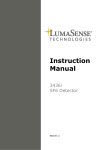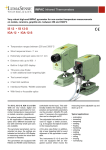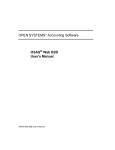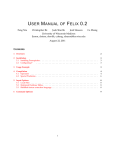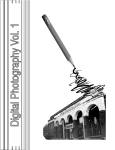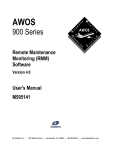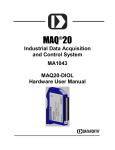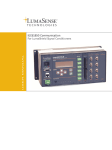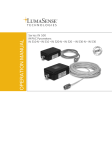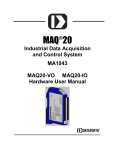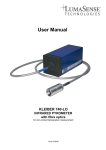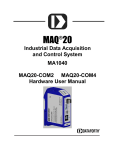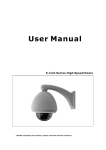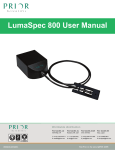Download MC320 Thermal Imager Manual
Transcript
MANUAL MC320 Thermal Imager Confidential Information The material contained herein consists of information that is the property of LumaSense Technologies and intended solely for use by the purchaser of the equipment described in this manual. All specifications are subject to change without notice. Changes are made periodically to the information in this publication, and these changes will be incorporated in new editions. LumaSense Technologies prohibits the duplication of any portion of this manual or the use thereof for any purpose other than the operation or maintenance of the equipment described in this manual, without the express written permission of LumaSense Technologies. Copyright © LumaSense Technologies 2012. All rights reserved. Trademarks All trademarks are trademarks, registered trademarks, and/or service marks of their respective holders. LumaSense Technologies 3301 Leonard Court Santa Clara, CA 95054 USA Telephone +1 (408) 727-1600 FAX +1 (408) 727-1677 E-mail [email protected] [email protected] Website http://www.lumasenseinc.com Americas and Australia Sales & Service Santa Clara, CA Ph: +1 800 631 0176 Fax: +1 408 727 1677 Europe, Middle East, Africa Sales & Service Frankfurt, Germany Ph: +49 69 97373 0 Fax: +49 69 97373 167 India Sales & Support Center Mumbai, India Ph: +91 22 67419203 Fax: +91 22 67419201 China Sales & Support Center Shanghai, China Ph: +86 133 1182 7766 Fax: +86 21 5877 2383 Part No. 532-0001-01 Rev. B February 2012 Contents 1 General Information ....................................................................................................... 5 1.1 1.2 1.3 1.4 1.5 2 Introduction .................................................................................................................... 9 2.1 2.2 2.3 2.4 2.5 2.6 2.7 2.8 3 System Overview ..................................................................................................... 9 Camera Interfaces ................................................................................................. 10 2.2.1 Rear Panel ............................................................................................................ 10 Lenses ................................................................................................................... 11 Environmental Conditions ..................................................................................... 11 Unpacking and Inspection ..................................................................................... 11 Storage ................................................................................................................. 12 Service Request or Repair ...................................................................................... 12 Shipments to LumaSense for Repair ...................................................................... 13 Getting Started ............................................................................................................. 15 3.1 3.2 3.3 3.4 3.5 3.6 4 Information about the User Manual ....................................................................... 5 1.1.1 Legend ................................................................................................................... 5 Operator Training ................................................................................................... 5 Regulatory Information .......................................................................................... 5 Disposal / Decommissioning .................................................................................... 6 Limit of Liability and Warranty ............................................................................... 7 Making the Connections ....................................................................................... 15 Connecting the Power........................................................................................... 15 Connecting Video Output ..................................................................................... 15 Connecting the Ethernet Cable ............................................................................. 15 3.4.1 Connecting the Camera to a Dedicated Computer ............................................. 16 3.4.2 Connecting the Camera to a Network Device ..................................................... 17 Installing the Software .......................................................................................... 18 Working with the Camera System ......................................................................... 18 3.6.1 Trigger Input ........................................................................................................ 18 3.6.2 LED Indicators ...................................................................................................... 18 3.6.3 External Monitors ................................................................................................ 18 Principle of Thermal Imaging ........................................................................................ 19 4.1 4.2 4.3 4.4 4.5 4.6 4.7 4.8 Infrared Radiation ................................................................................................. 19 Emissivity............................................................................................................... 20 Blackbody Radiation ............................................................................................. 20 Blackbody Type Source and Emissivity................................................................... 22 Determining Emissivity .......................................................................................... 23 Background Noise ................................................................................................. 25 Practical Measurement .......................................................................................... 25 Emissivity of Various Materials .............................................................................. 27 MC320 Thermal Imager Manual Contents iii 5 Appendix....................................................................................................................... 31 5.1 iv Specifications ........................................................................................................ 31 5.1.1 MC320 Variations ................................................................................................. 31 5.1.2 Optics ................................................................................................................... 31 5.1.3 Technical Data...................................................................................................... 31 5.1.4 Dimensions ........................................................................................................... 32 Contents MC320 Thermal Imager Manual 1 General Information 1.1 Information about the User Manual Congratulations on choosing the high quality and highly efficient LumaSense MC320 Thermal Imager. This manual provides important information about the instrument and can be used as a work of reference for installing, operating, and maintaining your MC320 Thermal Imager. It is important that you carefully read the information contained in this manual and follow all safety procedures before you install or operate the instrument. To avoid handling errors, keep this manual in a location where it will be readily accessible. 1.1.1 Legend Important Notes The note symbol indicates tips and useful information in this manual. All notes should be read to effectively operate the instrument. Warnings and Cautions The general warnings and cautions symbol signifies the potential for bodily harm or damage to equipment. Caution: The MC320 instrument is a sealed unit. Do not attempt to open the instrument housing as this will void the LumaSense warranty. Please refer to the warranty statement found in Section 1.5 of this manual. MC320 Thermal Imager Manual 1.2 Operator Training To best understand and utilize the measurements and images derived from the operation of this instrument, the operator should understand the basics of heat transfer and infrared radiation theory. Notes on these basics can be found in Section 4 of this manual. Qualified personnel should provide education and training in these subjects. 1.3 Regulatory Information This section describes how the Infrared camera complies with regulations in certain regions. Any modifications to the Infrared camera not expressly approved by the manufacturer could void the authority to operate the Infrared camera in these regions. General Information 5 USA This camera is prohibited to be resold, loaned or taken out of the USA unless an export license has been obtained from the US Department of Commerce. Any violation can result in severe criminal penalties. General conditions of operation. This Infrared camera generates, uses, and can radiate radio frequency energy that may interfere with radio and television reception. Persons operating intentional or unintentional radiators shall not be deemed to have any vested or recognizable right to continued use of any given frequency by virtue of prior registration or certification of equipment, or, for power line carrier systems, on the basis of prior notification of use pursuant to Sec. 90.63(g) of this chapter. Operation of an intentional, unintentional, or incidental radiator is subject to the conditions that no harmful interference is caused and that interference must be accepted that may be caused by the operation of an authorized radio station, by another intentional or unintentional radiator, by industrial, scientific and medical (ISM) equipment, or by an incidental radiator. The operator of a radio frequency device shall be required to cease operating the device upon notification by a Commission representative that the device is causing harmful interference. Operation shall not resume until the condition causing the harmful interference has been corrected. 1.4 Disposal / Decommissioning Inoperable thermal imagers must be disposed of in compliance with local regulations for electro or electronic material. 6 General Information MC320 Thermal Imager Manual 1.5 Limit of Liability and Warranty All general information and notes for handling, maintenance, and cleaning of this instrument are offered according to the best of our knowledge and experience. LumaSense Technologies is not liable for any damages that arise from the use of any examples or processes mentioned in this manual or in case the content of this document should be incomplete or incorrect. LumaSense Technologies reserves the right to revise this document and to make changes from time to time in the content hereof without obligation to notify any person or persons of such revisions or changes. All thermal imagers from LumaSense Technologies have a regionally effective warranty period, which is one year unless required by law. This warranty covers manufacturing defects and faults which arise during operation, only if they are the result of defects caused by LumaSense Technologies. There are no user-serviceable components in the camera. Disassembly of the camera is not allowed. The warranty is VOID if the camera is disassembled, tampered with, altered, or otherwise damaged without prior written consent from LumaSense Technologies; or if considered by LumaSense Technologies to be abused or used in abnormal conditions. MC320 Thermal Imager Manual General Information 7 To ensure consistent document formatting, this page was intentionally left blank. 8 General Information MC320 Thermal Imager Manual 2 Introduction The MC320 represents another milestone in innovative infrared thermal imaging. Designed with advanced maintenance-free electronics and industrial protective packing, the MC320 offers unparalleled accuracy for demanding industrial and scientific applications. With an unmatched array of protective accessories, the MC320 demonstrates LumaSense’s commitment to long-term trouble-free operation of these instruments. The MC320 quickly measures temperature without contact in even the most adverse environments. Its compact design provides for easy integration into standard enclosures for use in harsh environments and its full array of optional lenses meet the needs of most applications. The technique of thermal imaging, or thermography, is based on well-established technology and has been used for a wide variety of applications. However, implementing a systems approach for thermal process applications requires detailed knowledge of the specific application, available thermal imagers and thermal scanners, existing controls platform, and software requirements, etc. As such, we have a full staff of engineering and software specialists available for the design and development of comprehensive turn-key systems for all customer applications. Experience in many different thermal applications is the backbone of our designs and short-term turnaround for specialized software and custom camera configurations is our specialty. 2.1 System Overview The MC320 is intended to be integrated with the appropriate application-specific imaging components for use in process control, nondestructive testing, and diagnostic applications. It provides real-time digital image transfer and control using Gigabit Ethernet and provides an option for remote monitoring through a Local Area Network. As such, the MC320 thermal imaging system can be used as a machine vision system, operatorbased temperature monitoring system, fully automatic temperature control system, or stand-alone smart sensor for alarm temperature control. System Features (Dependent upon Specific Application Requirements) Imaging cameras, scanners, and associated equipment Image processing software, from existing modules in our extensive library or through customer software development The image processing unit or the image processing/control system MC320 Thermal Imager Manual Introduction 9 Integration with other devices in the process or other systems (PLCs, computers, SCADA and Distributed Control Systems (DCSs), other sensing devices, actuators, etc.) Housings and enclosures matched to the harsh environment (explosive, hazardous, outdoor, etc.) Custom-designed mechanical hardware Communication links Startup support LumaSense engineering staff and sales consultants follow a system approach to online thermal processing control. They have specific expertise and technical skills required to specify and integrate the appropriate application-specific imaging components with your existing control platform. LumaSense takes the ultimate responsibility for the thermal imaging system meeting your design specifications and saving you time, cost, and allocation of in-house resources. 2.2 Camera Interfaces 2.2.1 Rear Panel The rear panel of the MC320 supports connectors for the Gigabit Ethernet, BNC video output, Trigger, and DC Power input and mounting. BNC Video Out Trigger Input LEDs Rear Panel MC320 Camera DC Power Input Gigabit Ethernet The rear panel also provides three LED indicators. The POWER LED indicates that the camera has power. The COMM LED indicates that the camera has an Ethernet connection. The TRIGGER LED indicates that the Trigger is active (future capability). 10 Introduction MC320 Thermal Imager Manual 2.3 Lenses Caution: Do not use thinners, benzene or other chemicals to clean the lens as these will damage the lens coating. The MC320 is a process camera that has a full array of optional lenses available to meet the needs of most applications. However, because of the extreme and application-specific nature of the camera system, it is necessary that the appropriate lens be fitted and calibrated at the LumaSense Factory according to the application requirements. Contact LumaSense for further information on lens considerations for the MC320 thermal imaging system. 2.4 Environmental Conditions The MC320 has an internal temperature sensor in the detector and is designed to withstand ambient temperatures from 0°C to 50°C without a temperature-controlled enclosure. The temperature reading can be displayed and read by image processing software via the Gigabit Ethernet connection. In addition to temperature requirements, other environmental factors must also be considered when installing the MC320 thermal imaging system. For example, if the camera is going to be mounted in a harsh environment, certain precautions must be taken to secure and protect the system from its surroundings. Contact LumaSense for further information on environmental considerations and protective enclosures for the MC320 thermal imaging system. Caution: The package should be allowed to stabilize at room temperature before removing the instrument to prevent the formation of condensation. 2.5 Unpacking and Inspection Save all packing materials, including the carrier’s identification codes, until you have inspected the pyrometer and find that there is no obvious or hidden damage. Before shipment, the pyrometer was examined and has been tested. If you note any damage or suspect damage, immediately contact the carrier and LumaSense Technologies, Inc. When unpacking and inspecting your camera, you need to do the following: 1. Check all materials in the container against the enclosed packing list. LumaSense Technologies cannot be responsible for shortages against the packing list unless a claim is immediately filed with the carrier. Final claim and negotiations with the carrier must be completed by the customer. 2. Carefully unpack and inspect all components for visible damage. 3. Save all packing materials, including the carrier’s identification codes, until you have inspected all components and find that there is no obvious or hidden damage. MC320 Thermal Imager Manual Introduction 11 Before shipment, each camera is assembled, calibrated, and tested at the LumaSense Factory. If you note any damage or suspect damage, immediately contact the carrier and LumaSense Technologies, Inc. 2.6 Storage In case the instrument is not put into service immediately, it should be tested in the application or simulated application as promptly as practical to reveal any hidden damage. Unpleasant surprises can be avoided by briefly trying the instrument before putting it in storage. Storage temperature range is -20°C to 80°C (-4°F to 176°F). 2.7 Service Request or Repair Contact LumaSense Technologies Technical Support in case of a malfunction or service request. Provide clearly stated details of the problem as well as the instrument model number and serial number. Upon receipt of this information, Technical Support will attempt to locate the fault and, if possible, solve the problem over the telephone. If Technical Support concludes that the instrument must be returned to LumaSense Technologies for repair, they will issue a Return Material Authorization (RMA) number. Return the instrument upon receipt of the RMA number, transportation prepaid. Clearly indicate the assigned RMA number on the shipping package exterior. Refer to Section 2.8, Shipments to LumaSense for Repair, for shipping instructions. Technical Support can be contacted by telephone or email: Santa Clara, California Telephone (408) 727-1600 or 1-800-631-0176 Email [email protected] Frankfurt, Germany Telephone +49 69 97373 0 Email [email protected] Erstein, France Telephone +33 (0)3 88 98 98 01 Email [email protected] 12 Introduction MC320 Thermal Imager Manual 2.8 Shipments to LumaSense for Repair All RMA shipments of LumaSense Technologies instruments are to be prepaid and insured by way of preferred carrier. For overseas customers, ship units air-freight, priority one. The instrument must be shipped in the original packing container or its equivalent. LumaSense Technologies is not responsible for freight damage to instruments that are improperly packed. Clearly indicate the assigned RMA number on the shipping package exterior. If no RMA is indicated, shipment will not be accepted Send RMA Shipments to your nearest technical service center: MC320 Thermal Imager Manual Santa Clara, California Frankfurt, Germany LumaSense Technologies, Inc. 3301 Leonard Court Santa Clara, CA 95054 USA Telephone: (408) 727-1600 1-800-631-0176 LumaSense Technologies GmbH Kleyerstr. 90 60326 Frankfurt Germany Telephone: +49 69-97373 0 Email: [email protected] Email: [email protected] Introduction 13 To ensure consistent document formatting, this page was intentionally left blank. 14 Introduction MC320 Thermal Imager Manual 3 Getting Started The MC320 camera is configured to operate under certain conditions according to user-defined specifications. As such, the camera is assembled, calibrated, and tested at the LumaSense Factory and is delivered with the necessary components to create a fully-operational system. Assemble the system by connecting the cables as shown on the System Configuration and Wiring drawing supplied with the system. Caution: Because the MC320 system is designed for specific application situations, it is imperative that you configure your system in accordance with the LumaSense electrical diagrams which were supplied with your system. 3.1 Making the Connections In order for the MC320 system to operate correctly, the supplied hardware must be properly attached to the computer and power supplied to the various parts of the system. 3.2 Connecting the Power Insert the power cable into the DC In terminal located on the rear panel of the camera. Alternatively, the camera can be powered via a PoE (Power-overEthernet) capable Ethernet switch. In this case, the power connection can be left open. 3.3 Connecting Video Output A standard NTSC or PAL monitor can be directly connected to BNC video output connector. The default setting in the camera is NTSC standard, but it can be configured to PAL standard via the software. To connect the Video Output: 1. Remove the cap over the Video terminal. 2. Connect the video cable. 3. Twist to lock the connector into place. 3.4 Connecting the Ethernet Cable Typically, the system is set up by either connecting the camera to a network device (switch) or by connecting the camera directly to a dedicated computer using a crossover Ethernet cable. The camera is PoE (Power-over-Ethernet) capable. To use this feature, the camera has to be connected to a PoE enabled Ethernet switch. There is no need for connecting a power supply in this case. MC320 Thermal Imager Manual Getting Started 15 3.4.1 Connecting the Camera to a Dedicated Computer Connecting the MC320 to a computer using a crossover cable To Connect the Camera to a Dedicated Computer: 1. Connect one end of the RJ45 (Ethernet) crossover cable to the Ethernet port on the camera and the other end to the computer. 2. Connect the camera power supply to the camera. 3. Turn on the computer to connect the camera to the computer. 4. Consult the software manual for setup and configuration instructions necessary to make the system operational. 16 Getting Started MC320 Thermal Imager Manual 3.4.2 Connecting the Camera to a Network Device Connecting the MC320 to a computer using a patch cable To Connect the Camera to a Network Device: Note: The MCL320 requires a Gigabit Ethernet network adapter. An appropriate adapter will be supplied with the camera. All cabling should be Cat 5e or Cat 6. MC320 Thermal Imager Manual 1. Connect one end of an RJ45 Ethernet patch cable to the Ethernet port on the camera and the other end to the switch. 2. Connect one end of another RJ45 Ethernet patch cable to your computer and the other end to the switch. 3. Connect the camera power supply to the camera. 4. Turn on the computer. 5. Consult the software manual for setup and configuration instructions necessary to make the system operational. Getting Started 17 3.5 Installing the Software If your system was delivered with LumaSense’s thermal imaging software, then you have available all the necessary executables and support files needed for remote camera control operations. For information on installing and using the software, refer to the software manual that came with your system. 3.6 Working with the Camera System Your LumaSense software was shipped with preconfigured camera settings based upon the system you purchased. The software package contains all the controls you will need to setup, run, and monitor the system using a single computer. For more information on working with your Camera System, refer to the software manual that came with your system. 3.6.1 Trigger Input Although the camera does not currently support inputs, it does come equipped with a hardware interface to allow the future capability of supporting inputs. Two possible future upgrades using this interface are NUC disable, which would be used in the event an object of interest is approaching; or frame trigger, which would be used to capture a frame based on an input signal. Currently the camera does not supports inputs, the hardware is supplied to support future capabilities. 3.6.2 LED Indicators The MC320 provides three LED indicators. The POWER LED indicates that the camera has power. The COMM LED indicates that the camera has an Ethernet connection. The TRIGGER LED indicates that the Trigger is active (future capability). 3.6.3 External Monitors A standard NTSC or PAL monitor can be directly connected to BNC video output connector. The default setting in the camera is NTSC standard, but it can be configured to PAL standard via the software. 18 Getting Started MC320 Thermal Imager Manual 4 Principle of Thermal Imaging All materials above 0 degrees Kelvin (-273 degrees C) emit infrared energy. The infrared energy emitted from the measured object is converted into an electrical signal by the imaging sensor in the camera and displayed on a monitor as a color or monochrome thermal image. The basic principle is explained in the following sections. 4.1 Infrared Radiation The infrared ray is a form of electromagnetic radiation the same as radio waves, microwaves, ultraviolet rays, visible light, X-rays, and gamma rays. All these forms, which collectively make up the electromagnetic spectrum, are similar in that they emit energy in the form of electromagnetic waves traveling at the speed of light. The major difference between each ‘band’ in the spectrum is in their wavelength, which correlates to the amount of energy the waves carry. For example, while gamma rays have wavelengths millions of times smaller than those of visible light, radio waves have wavelengths that are billions of times longer than those of visible light. A Spectrum of Electromagnetic Radiation The wavelength of the infrared radiation ‘band’ is 0.78 to 1000µm (micrometers). This is longer than the wavelength of visible light yet shorter that radio waves. The wavelengths of infrared radiation are classified from the near infrared to the far infrared. MC320 Thermal Imager Manual Principle of Thermal Imaging 19 4.2 Emissivity Infrared radiation is energy radiated by the motion of atoms and molecules on the surface of object, where the temperature of the object is more than absolute zero. The intensity of the emittance is a function of the temperature of the material. In other words, the higher the temperature, the greater the intensity of infrared energy that is emitted. As well as emitting infrared energy, materials also reflect infrared, absorb infrared and, in some cases, transmit infrared. When the temperature of the material equals that of its surroundings, the amount of thermal radiation absorbed by the object equals the amount emitted by the object. Transmission, Absorption, and Reflection of Infrared Energy The figure above shows the three modes by which the radiant energy striking an object may be dissipated. These modes of dissipation are: a = absorption t = transmission r = reflection The fractions of the total radiant energy, which are associated with each of the above modes of dissipation, are referred to as the absorptivity (a) transmissivity (t) and the reflectivity (r) of the body. According to the theory of conservation of energy, the extent to which materials reflect, absorb and transmit IR energy is known as the emissivity of the material. 4.3 Blackbody Radiation The emissivity of a body is defined formally by the equation below as the ratio of the radiant energy emitted by the body to the radiation, which would be emitted by a blackbody at the same temperature. 20 Principle of Thermal Imaging MC320 Thermal Imager Manual Note: A blackbody is a theoretical surface, which absorbs and reradiates all the IR energy it receives. It does not reflect or transmit any IR energy. Perfect blackbody surfaces do not exist in nature. Where, Wo = total radiant energy emitted by a body at a given temperature T. Wbb = total radiant energy emitted by a blackbody at the same temperature T. If all energy falling on an object were absorbed (no transmission or reflection), the absorptivity would equal to 1. At a steady temperature, all the energy absorbed could be re-radiated (emitted) so that the emissivity of such a body would equal 1. Therefore in a blackbody, absorptivity = emissivity = 1 Practical real life objects do not behave exactly as this ideal, but as described with transmissivity and reflectivity, absorptivity + transmissivity + reflectivity = 1 Planck’s Law Energy radiated from the blackbody is described as follows [“Planck’s Law”.] 1) Stefan Bolzmann’s equation In order to obtain total radiant emittance of the blackbody, integrate the equation (1) through all wavelengths (0 to infinity). The result is as follows and is called “Stefan-Bolzmann equation.” 2) Wien’s displacement law The temperature of blackbody can be obtained directly from the radiant energy of the blackbody by this equation. In order to find out the wavelength on the maximum spectral radiant emittance, differentiate Planck’s law and take the value to 0. 3) The equation is called “Wien’s displacement law”. MC320 Thermal Imager Manual Principle of Thermal Imaging 21 Where in (1) to (3), In radiation of a normal object, as the emissivity is (<1) times of the blackbody, multiply above equation by the emissivity. The following figures show the spectral radiant emittance of a blackbody. (a) is shown by logarithmic scale and (b) is shown by linear scale. Spectral radiant emittance of a blackbody The graphs show that wavelength and spectral radiant emittance vary with the temperature. They also show that as the temperature rises, the peak of spectral radiant emittance is shifting to shorter wavelengths. This phenomenon is observable in the visible light region as an object at a low temperature appears red, and as the temperature increases, it changes to yellowish and then whitish color—thus shifting to shorter and shorter wavelengths as the temperature increases. Key: a = absorptivity t = transmissivity r = reflectivity e = emissivity 22 4.4 Blackbody Type Source and Emissivity Although a blackbody is actually only a theoretical ideal, an object can be manufactured which approximates it. A law closely related to the blackbody is Kirchhoff’s law that defines reflection, transmission, absorption and radiation. Principle of Thermal Imaging a=e=1 MC320 Thermal Imager Manual Absorptivity equals emissivity, thus emissivity can be described by reflectivity and transmissivity. e+t+r=1 In order to obtain the true temperature of an object, it is necessary to obtain the emissivity correctly. Therefore, the emissivity of the object has to be measured by using a blackbodytype source which is closest to an ideal blackbody as possible. The blackbody-type source can be designed to meet the conditions pointed out by Kirchoff where “the radiation within an isothermal enclosure is blackbody radiation.” As a blackbody-type source for a measurement must radiate outside of the enclosed surface, a small hole is cut through the wall of the enclosure small enough not to disturb the blackbody condition. The radiation leaving this hole should closely approximate that of a blackbody. When the diameter of the hole is as 2r and the depth is as L, if L/r is equal or more than 6, it is used as a blackbody-type source for practical use. The following figure shows an example of a blackbody-type source based on blackbody conditions. 4.5 Determining Emissivity Emissivity is the ratio of energy radiated from an object to the exterior and energy radiated from a blackbody. The emissivity varies with the surface condition of the object and also with temperature and wavelength. If this value is not accurate, then the true temperature cannot be measured. In other words, a variation or change in emissivity will cause a change in the indications on a thermal imager. To approach the true temperature therefore, The emissivity must approximate 1.0 ( must be nearly a blackbody). The measured object The emissivity must be corrected ( The emissivity of the measured object must be internally corrected to 1 by the thermal imager). Therefore, in order to perform correct measurement for true temperature, the emissivity is determined as follows: MC320 Thermal Imager Manual Principle of Thermal Imaging 23 1. By means of a printed table Various books and literature carry physical constants tables, but if the measuring condition is not identical, the constants may not usable. In such cases the literature should be used only for reference. 2. Determination by ratio — Option 1 A contact-type thermometer is used to confirm that the measured object is in thermal equilibrium and that the blackbody-type source is at the same temperature. The object and the blackbody-type source are then measured with the radiation thermometer and the resulting energy ratio is then used to define the emissivity as follows: EK : energy of blackbody-type source ES: energy of measured object X: emissivity of measured object Where, EK : ES = 1 : X 3. Determination by ratio — Option 2 An object, resembling a blackbody, is attached to a heat source to make the temperature of the blackbody part and the measuring object the same. The ratio of infrared radiation energies are then determined as in #2 above. 4. Comparison with blackbody surface — Option 1 A very small hole is made in the measured object to satisfy the aforementioned blackbody conditions, and to make the temperature of the entire object uniform. Then, using the emissivity correcting function of thermal imager, the emissivity is reduced until the temperature of the point to be measured equals the temperature of the small hole measured at an emissivity of 1. The emissivity setting should be the emissivity of the object. (This applies only when the conditions are the same as at measurement.) 5. Comparison with blackbody surface — Option 2 If a small hole cannot be made in the object, then the emissivity can be obtained by applying black paint to the object and reaching a thermal equilibrium through similar procedures. But since the painted object will not provide a complete blackbody, the emissivity of the painted object needs to be set first and then the temperature can be measured. The following figure shows examples of blackbody paint. 24 Principle of Thermal Imaging MC320 Thermal Imager Manual 4.6 Background Noise Note: For low temperatures, masking tape or cornstarch can be used. When measuring the temperature of an object by a radiation thermometer, it is important to take into consideration the above-mentioned emissivity correction as well as the environmental conditions where the measurements will be performed. Infrared rays enter the thermal imager from the measuring object as well as all other objects nearby. Therefore, in order to avoid this influence, a function of environment reflection correction, etc. is required. Also, when accurate data is required, it is necessary to minimize the influence by shortening the transmission route of the infrared ray, for example. The following methods may be useful to reduce background noise. 1. Shorten the distance between the measured object and of the thermal imager. Please keep a safe distance to protect the operator as well as the instrument. 2. Have no high temperature object behind the measured object, such as the sun shining on the back of the measured object. 3. Do not allow direct sunlight to strike thermal imager. 4. Do not allow obstacles such as dust or vapor (which attenuates the infrared signal) between the measured object and the thermal imager. 4.7 Practical Measurement Note: If you already know the emissivity, you can make thermal imaging measurements immediately. There are a number of methods for correcting emissivity in order to obtain the true temperature. The correction procedure with each method will be explained next. 1. Method of comparison or direct measurement with emissivity equal to approximately 1.0 1. Stabilize the temperature of the measured object or similar material. 2. Open a very small hole (hereafter called blackbody part) in the object which the thermal imager must measure as to satisfy blackbody conditions. 3. Then set the emissivity correcting function of thermal imager so that the temperature of the blackbody part and the measured surface will be the same. The obtained emissivity will be the emissivity of the measured surface. MC320 Thermal Imager Manual Principle of Thermal Imaging 25 4. Thereafter when measuring the same type object, it is unnecessary to change the emissivity setting. 2. Method of direct measurement of emissivity If a hole cannot be made as in method 1, then apply black high emissivity paint and carry out the same procedures to obtain the emissivity. Since the black paint will not provide a perfect blackbody, first set the emissivity of the black paint and then measure the temperature. 3. Indirect measurement Measure a sample similar to the measured object, and place it in a condition able to be heated by a heater, etc. Then measure the object and the sample alternately with the camera and when the indicated values are identical, measure the sample with a contact-type thermometer. Adjust the emissivity of the thermal imager to cause the temperature readout to match that of the contact measurement. The resulting emissivity is that of the sample. 4. Measuring by Wedge effect With this method, the emissivity of the measured surface itself is enhanced through use of the wedge or semiwedge effect. But one must be careful about the number of reflections and/or the measuring angle. A small change in angle will reduce the emissivity enhancement. Measuring by Wedge effect 26 Principle of Thermal Imaging MC320 Thermal Imager Manual 4.8 Emissivity of Various Materials From “Infrared Radiation, a Handbook for Applications” by Mikael A. Bramson MC320 Thermal Imager Manual Principle of Thermal Imaging 27 28 Principle of Thermal Imaging MC320 Thermal Imager Manual MC320 Thermal Imager Manual Principle of Thermal Imaging 29 30 Principle of Thermal Imaging MC320 Thermal Imager Manual 5 Appendix 5.1 Specifications 5.1.1 MC320 Variations Model Filter Range 1 (°F) Range 2 (°F) Range 1 (°C) Range 2 (°C) MC320L 8 - 14 µm -40°F to 248°F 32°F to 932°F -40°C to 120°C 0°C to 500°C MC320HT 8 - 14 µm MC320M 3 - 5 µm MC320MHT 3 - 5 µm 752°F to 2912°F MC320F 3.9 µm 392°F to 1472°F 200°C to 800°C MC320FHT 3.9 µm 752°F to 2912°F 400°C to 1600°C MC320G 4.8 - 5.2 µm 392°F to 1472°F 200°C to 800°C MC320GHT 4.8 - 5.2 µm 752°F to 2912°F 400°C to 1600°C -392°F to 2912°F 302°F to 932°F 200°C to 2000°C 392°F to 1472°F 150°C to 500°C 200°C to 800°C 400°C to 1600°C 5.1.2 Optics Lens Field of View Lens Field of View Standard 21° (H) x 16° (V) 2X Telephoto 11° (H) x 8° (V) XWide (manual focus) 75° (H) x 56° (V) Close focus 60 m resolution Wide 53° (H) x 40° (V) Boroscope ready User defined 5.1.3 Technical Data Performance Measurement Accuracy: Image Update Rate: A/D Resolution: Detector Emissivity Correction: ±2°C or 2% of reading 60 Hz (standard); 9 Hz (E series) 16 bit 320 x 240 Uncooled Focal Plane Array 0.1 to 1.0 Transmittance Sensitivity/NETD 0.1 to 1.0 0.108°F @ 86°F (0.06°C @ 30°C) Optical Specifications Focus Range: 30 cm to infinity Environmental Specifications Protection Class: Operating Temperature: Storage Temperature: Relative Humidity: Weight: Operating Position: Housing: Dimensions: MC320 Thermal Imager Manual IP54 / NEMA 4 32 to 122°F (0°C to 50°C) (at housing) -4 to 158°F (-20°C to 70°C) Non condensing conditions 2.55 lbs. (1 kg) (excludes any protective housing or optional lenses) Any operating position 6063 T5 Aluminum Alloy. Finish is alodine, clear, MIL-DTL-5541F, RoHS Compliant 3.25 in x 3.25 in x 7.75 in (83 mm x 83 mm x 197 mm) Appendix 31 Interface Analog: TV Output (NTSC or PAL) Digital: Connections: Gigabit Ethernet 4-pin Power, RJ45 Ethernet, 3-pin Trigger, Coaxial (BNC) Electrical Power Supply: Power Consumption: Load (analog output): Isolation: 12 -30V or Power-over-Ethernet standards 7W Typical, 13W Max 75 Power supply, communication, and IOs are isolated from each other Scope of delivery Includes 2 meter Ethernet crossover cable, 2 meter power supply cable, power supply unit (100…240 VAC, 47…63 Hz), lens cap, manual (on CD), carrying case, LumaSpec RT Viewer software. 5.1.4 Dimensions 32 Appendix MC320 Thermal Imager Manual


































